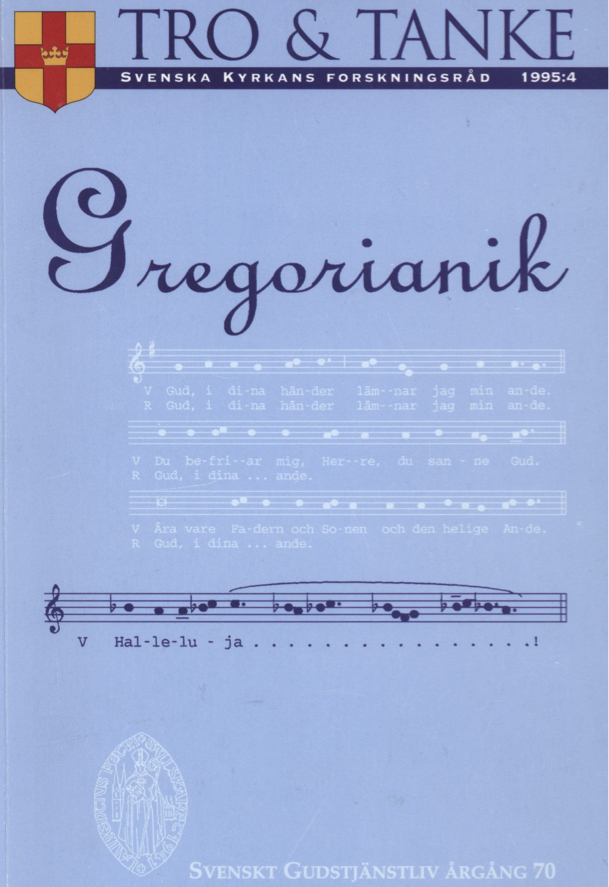Gregorianik i Sverige genom tiderna
Abstract
When Gregorian chant was reintroduced in the Lutheran Church of Sweden at the beginning of this century, some remnants of an older tradition were still alive. Example 1 is a transcription of a recording from 1938 of Luther’s "Jesaja, dem Propheten, das geschah" in Swedish translation with a tune which has no resemblance with the official one. Like the traditional music for Psalms 1 and 2 as printed in 1874 (example 2) and for the Christmas epistle (Is 9:2—7) as written down ca 1860, it can be regarded as a variant of the tonus peregrinus which was to be found in the Swedish hymnal up to 1820 (example 3). Even in the mocking dialogue between a clergyman and his assistant in example 4 one can see traces of old liturgical song patterns. The study of ecclesiastical singing in popular tradition - for which ethnohymnology seems to be a convenient term - is one of the main aims of the Nordiskt institut fö hymnologi (NORDHYMN), founded in 1988.
One side of the liturgical restoration movement which culminated in Sweden around 1960 was the interest in Gregorian chant. Today one can find not only different Gregorian alternatives for the ordinary of the Mass but also some 50 introits, several psalms and office hymns etcetera in the authorized liturgical books, all with Swedish texts. There is also an unofficial Swedish Antiphonary. No thorough analysis of the development of Gregorian chant in Sweden during the 20th century has yet been made.
Both in editing and performing this repertory the rhythmical aspect has caused severe problems. At the beginning, it was regarded natural to use metrical patterns as shown in example 5. Later the Solesmes equalism was held as the ideal but the newest wave of interest in Gregorian chant is inspired by other models, e.g. the two Hungarian specialists Laszlo Dobszay and Janka Szendrei. In 1994 they made a recording of the office for the medieval national saint of Sweden, The Historia of St. Erik.
If one follows the history of Gregorian chant in Sweden backwards from our century, one will hardly find anything at all of the old tradition in the 19th century. There was no official liturgical music, only small private editions. From some of these, published around 1800, three versions of the same Sanctus melody are quoted in examples 6d-f. They are very dissimilar but, as the juxtaposition shows, they all have their roots in the official, at that time obsolete, version from 1697 which in its turn is very close to the Latin version in the prereformation Swedish source A 54 (example 6b). This period has been studied in my dissertation, the summary of which has the title Liturgischer Gesang in der schwedischen Kirche 1697-1897 (Uppsala 1970).
The 17th century church music in Sweden was characterized by stylis tic changes that, step by step, broke down the old Gregorian traditions. One should not believe that this was the direct result of the Lutheran reformation around 1530. Even if the new hymns in Swedish were given place in the service, Gregorian chant in Latin or Swedish was still domi nating, at least in cities with Latin schools. Several editions and studies concerning the Gregorian chant during the Reformation time have been published by C-A Moberg, N Fransen, A Adell, J Jacobsson, P Edwall and others.
Section 5 is a survey of the research on Gregorian chant in Sweden betöre the Reformation. As most titles mentioned there are in English or German, there is no need for repeating them here. But some things are published only in Swedish, e g the investigations on the celebration of the Mass in medieval parishes by S Helander, S-E Pemler, A Piltz and B Stolt (Mässa i medeltida socken 1993). Their work has been the background for a reconstruction in 1989 of a medieval Mass which is available as a video cassette (Ecclesia Endre Anno Domini MCCCL).
Section 6 is devoted to the ca 17 000 medieval parchment fragments preserved in Swedish archives, many of which contain liturgical music. A series of articles on these treasures were published in 1993 under the title of Helgerånet (ed. K. Abukhantusa et al). Among them, there are also two musicological contributions by Ann-Marie Nilsson and Viveca Servatius.
The Scandinavian perspective in the last section is caused by the fact that this paper in its first version was read at a Gregorian conference, held in 1992 at Trondheim, Norway. The conference was part of a bigger project, the creation of a Gregorian centre at Trondheim. It is being hoped that such a centre, combining research and practice, will extend its working field to all Scandinavia.
Downloads
Published
Issue
Section
License
© the authors, Laurentius Petri Sällskapet för Svenskt Gudstjänstliv and Artos & Norma Bokförlag. Copying and using material from Svenskt Gudstjänstliv for scholarly purposes is permitted as long as the source is indicated. For other uses, please contact the respective author as well as the publisher. Special restrictions may apply to images.


